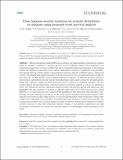Dose response severity functions for acoustic disturbance in cetaceans using recurrent event survival analysis
Date
20/11/2015Author
Grant ID
N00014-12-1-0204
N00014 08 1 0984
Keywords
Metadata
Show full item recordAbstract
Behavioral response studies (BRSs) aim to enhance our understanding of the behavior changes made by animals in response to specific exposure levels of different stimuli, often presented in an increasing dosage. Here, we focus on BRSs that aim to understand behavioral responses of free-ranging whales and dolphins to manmade acoustic signals (although the methods are applicable more generally). One desired outcome of these studies is dose-response functions relevant to different species, signals and contexts. We adapted and applied recurrent event survival analysis (Cox proportional hazard models) to data from the 3S BRS project, where multiple behavioral responses of different severities had been observed per experimental exposure and per individual based upon expert scoring. We included species, signal type, exposure number and behavioral state prior to exposure as potential covariates. The best model included all main effect terms, with the exception of exposure number, as well as two interaction terms. The interactions between signal and behavioral state, and between species and behavioral state highlighted that the sensitivity of animals to different signal types (a 6–7 kHz upsweep sonar signal [MFAS] or a 1–2 kHz upsweep sonar signal [LFAS]) depended on their behavioral state (feeding or nonfeeding), and this differed across species. Of the three species included in this analysis (sperm whale [Physeter macrocephalus], killer whale [Orcinus orca] and long-finned pilot whale [Globicephala melas]), killer whales were consistently the most likely to exhibit behavioral responses to naval sonar exposure. We conclude that recurrent event survival analysis provides an effective framework for fitting dose-response severity functions to data from behavioral response studies. It can provide outputs that can help government and industry to evaluate the potential impacts of anthropogenic sound production in the ocean.
Citation
Harris , C M , Sadykova , D , De Ruiter , S L , Tyack , P L , Miller , P , Kvadsheim , P , Lam , F-P & Thomas , L 2015 , ' Dose response severity functions for acoustic disturbance in cetaceans using recurrent event survival analysis ' , Ecosphere , vol. 6 , no. 11 , 236 , pp. 1-14 . https://doi.org/10.1890/ES15-00242.1
Publication
Ecosphere
Status
Peer reviewed
ISSN
2150-8925Type
Journal article
Description
This work was financially supported by the U. S. Office of Naval Research grant N00014‐12‐1‐0204, under the project “Multi‐study Ocean acoustics Human effects Analysis” (MOCHA). . L. Tyack received funding from the MASTS pooling initiative (The Marine Alliance for Science and Technology for Scotland) and their support is gratefully acknowledged. MASTS is funded by the Scottish Funding Council (grant reference HR09011) and contributing institutions. The case study data were provided by the 3S project, which was funded by the U.S. Office of Naval Research, the Norwegian Ministry of Defense, the Netherlands Ministry of Defense, and WWF Norway.Collections
Items in the St Andrews Research Repository are protected by copyright, with all rights reserved, unless otherwise indicated.

